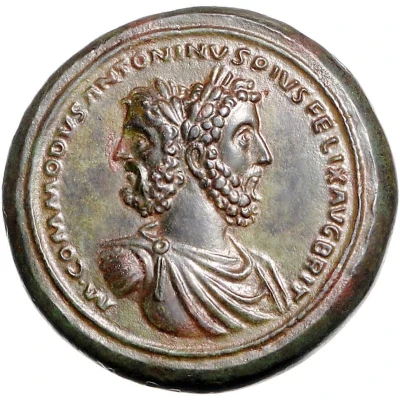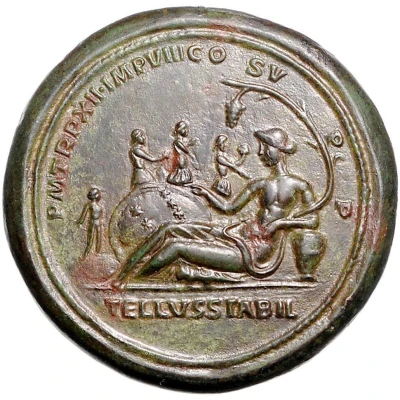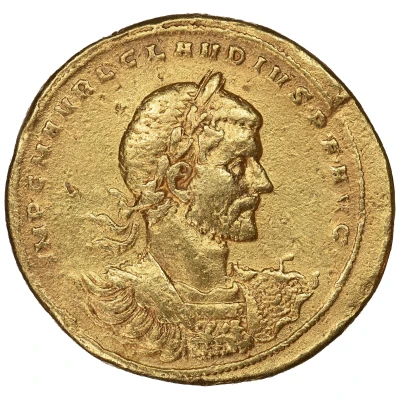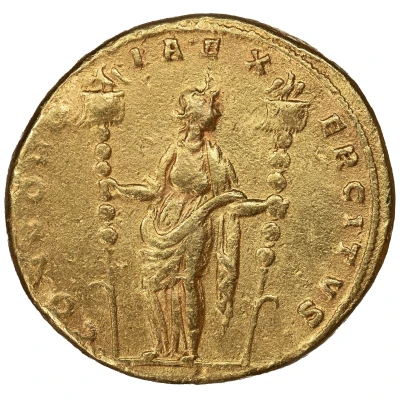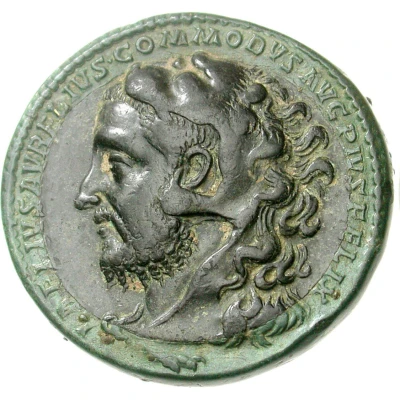
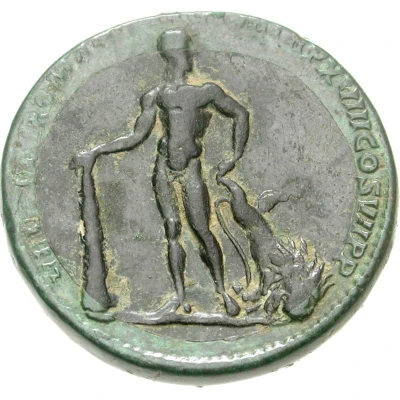

© Classical Numismatic Group, Inc.
New Year Medallion - Commodus Hercules; bimetallic
192 year| Bimetallic: bronze centre in orichalcum ring | 63.85 g | - |
| Location | Rome › Roman Empire (27 BC - 395 AD) |
|---|---|
| Emperor | Commodus (Lucius Aurelius Commodus) (177-192) |
| Type | Commemorative medals › Personality medals |
| Year | 192 |
| Composition | Bimetallic: bronze centre in orichalcum ring |
| Weight | 63.85 g |
| Shape | Round (irregular) |
| Technique | Hammered |
| Orientation | Medal alignment ↑↑ |
| Demonetized | Yes |
| Updated | 2024-11-14 |
| Numista | N#372799 |
|---|---|
| Rarity index | 100% |
Reverse
Hercules, nude, standing, looking right, resting right hand on club set on ground, and holding rear paw of Nemean Lion in left hand.
Script: Latin
Lettering: HERCVLI ROMANO AVG P M TR P XVIII COS VII P P
Comment
Minted 10-31 December AD 192.Apart from normal coinage intended for general circulation, Roman emperors struck large medallions intended as awards of merit or distinctions handed out to foreign dignitaries, high-ranking government and military officials on important occasions, often to mark the beginning of a new year.
Starting with the reign of Hadrian, some of these medallions were minted on bimetallic flans with a bronze or copper centre and an orichalcum outer ring.
Commodus and the cult of Hercules
During the latter part of his reign, Emperor Commodus started to associate himself with the mythological hero Hercules. The previous Antonine emperors had also done this but Commodus was more assertive, building statues of himself wearing a lion skin and carrying a club, the two main attributes of Hercules.
In the autumn of 192 AD, Commodus assumed tribunician power for the 18th time, officially adopted the name Hercules, and started to mint coins and medallions showing him wearing a lion skin. These coins and medallions are exceedingly rare because only a few weeks after they were introduced, on 31 December AD 192, Commodus was assassinated by an athlete in his bath.
Commodus-Hercules coins
A single denarius type and one sestertius are known with the inscription "TR P XVIII", indicating that the minting had barely started when Commodus was assassinated.
Commodus-Hercules medallions
The medallions were probably the prototypes for regular issues of coinage the following year. Unlike the coinage, the medallions were meant to be presented to government officials and the military leaders on Commodus’s 18th tribunician anniversary in 192 AD rather than on 1 January 193 AD. Therefore, a few more medallions than coins are known.
According to Jocelyn Toynbee, there are six die-linked types of Hercules medallions of Commodus, with thirty-nine known specimens in 1944. The obverses show Commodus wearing the lion skin, while the reverses allude in some way to Hercules, who sometimes bears a distinct resemblance to the emperor. All medallions are struck on bimetallic flans. Apart from one type showing the emperor plowing the pomerium (religious city boundary), which was a medallic version of a very rare type minted earlier in 190-192 AD, all the others are of a new type, distinct from regular coinage.
Source:
Jocelyn Toynbee; 1944. Roman Medallions. Numismatic Studies #5. The American Numismatic Society, New York, United States.
